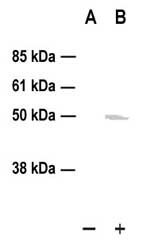PC386
PhosphoDetect Anti-p53 (pSer¹⁵) (Ab-3) Rabbit pAb
liquid, Calbiochem®
About This Item
origen biológico
rabbit
Nivel de calidad
forma del anticuerpo
affinity isolated antibody
tipo de anticuerpo
primary antibodies
clon
polyclonal
formulario
liquid
no contiene
preservative
reactividad de especies
rat, mouse, human
fabricante / nombre comercial
Calbiochem®
condiciones de almacenamiento
OK to freeze
isotipo
IgG
Condiciones de envío
wet ice
temp. de almacenamiento
−20°C
modificación del objetivo postraduccional
phosphorylation (pSer15)
Información sobre el gen
human ... TP53(7157)
Descripción general
Inmunógeno
Aplicación

Immunoblotting (1:1000)
Immunoprecipitation (1:200)
Advertencia
Forma física
Reconstitución
Nota de análisis
PC-12, HCT116, or HeLa cells treated with DNA damaging agents
Otras notas
Levine, A.J. 1997. Cell88, 323.
Milczarek, G.J., et al. 1997. Life Sci.60, 1.
Shieh, S.Y., et al. 1997. Cell91, 325.
Meek, D.W. 1994. Semin Cancer Biol.5, 203.
Información legal
¿No encuentra el producto adecuado?
Pruebe nuestro Herramienta de selección de productos.
Código de clase de almacenamiento
10 - Combustible liquids
Clase de riesgo para el agua (WGK)
WGK 2
Certificados de análisis (COA)
Busque Certificados de análisis (COA) introduciendo el número de lote del producto. Los números de lote se encuentran en la etiqueta del producto después de las palabras «Lot» o «Batch»
¿Ya tiene este producto?
Encuentre la documentación para los productos que ha comprado recientemente en la Biblioteca de documentos.
Nuestro equipo de científicos tiene experiencia en todas las áreas de investigación: Ciencias de la vida, Ciencia de los materiales, Síntesis química, Cromatografía, Analítica y muchas otras.
Póngase en contacto con el Servicio técnico